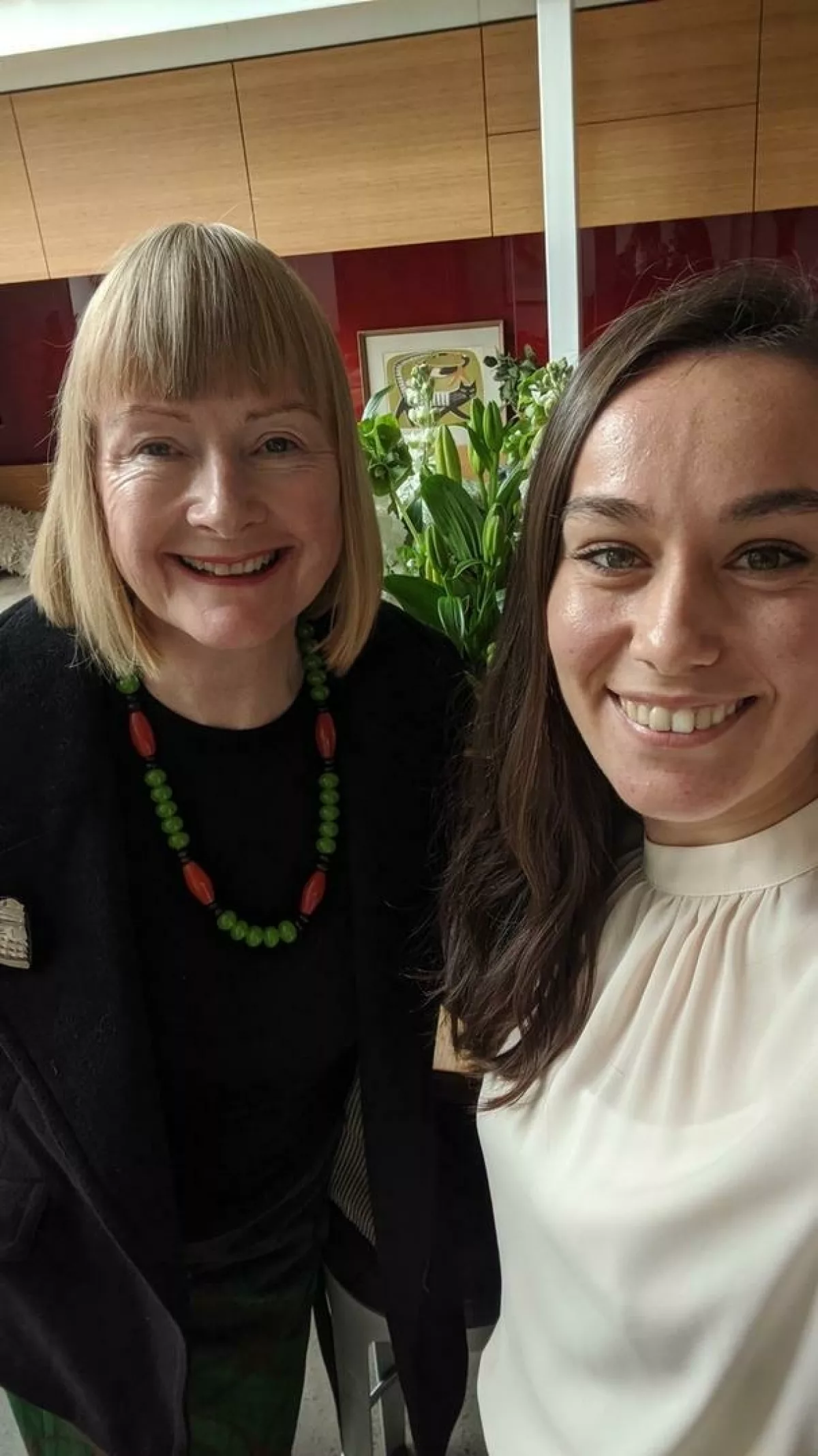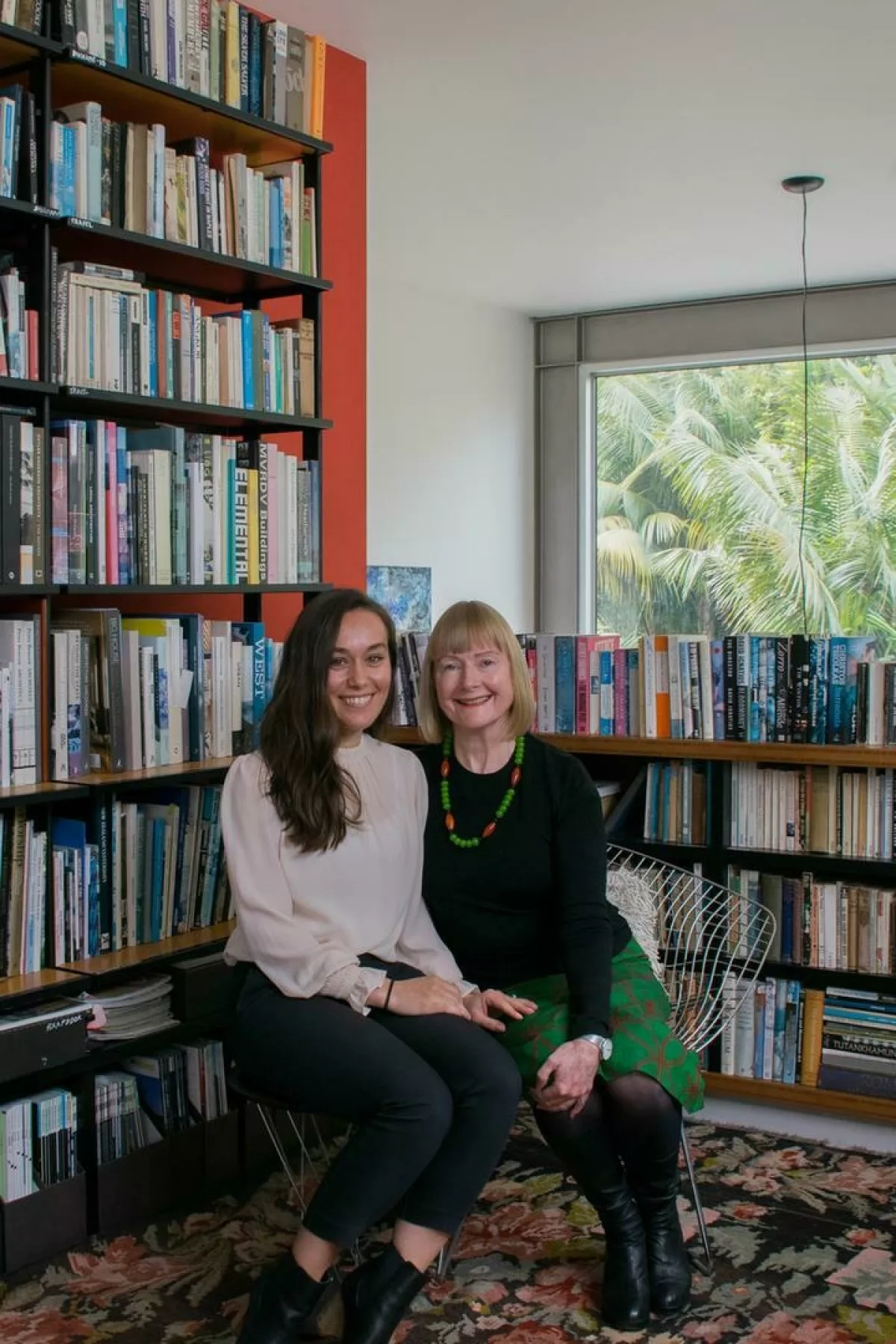WikiLounge: Co-Chair Lindley Naismith Interview by Blagica Maneva
08 Oct 2019
On Friday 27 September 2019, A+W NZ member Blagica Maneva interviewed new Co-Chair Lindley Naismith as part of our ongoing A+W NZ WikiLounge Project.
The transcript of the interview is below;
Blagica Maneva: As you might be aware, there is an international education and advocacy program called WikiD:women, their aim is to increase the representation of women in the build environment specifically on Wikipedia and to build their profiles so they can be visible to the public and know what their work was and how they were developing. They have started this project in 2014 and it’s a collaboration between Parlour, Architexx and N-ails. They have implemented the program in New York, Berlin and Australia, respectively of their companies location. And as part of A+W New Zealand, we want to promote the visibility of women in the architecture industry and expand the directory of New Zealand Architects on Wikipedia. And today we are talking with our own architectural pioneer in New Zealand Lindley Naismith. On behalf of A+W NZ, I would like to say thank you for agreeing to discuss about your life with me today.
Lindley Naismith: Thanks Blagica, it’s a bit of an overstatement to use the word pioneer. I’m flattered and thank you.
Blagica Maneva: You live up to it. I mean, alongside your award winning practice Scarlet Architects, you are now co-chair of the organization that I'm speaking on behalf now, A+W NZ and you have been on countless committees, juries, you have been a part of lots of institutions, and groups, you have contributed to the community and also you have contributed to the educational part in the architectural industry as well. You are quite involved in all of this. So you do deserve that word.
Lindley Naismith: There were many that came before. Just not as many women as men that’s all, not enough.
Blagica Maneva: I would like to start from 1982. That's the year when you graduated, Is that right?
Lindley Naismith: Yes I think that’s right, my final year was 1981 at the School of Architecture, and I graduated in 1982.
Blagica Maneva: Tell me, at that time, because 1982 seems a long time ago, and based on the research that I did, it seems like a year when women were really discriminated both in university and in the workforce, especially when they were expecting a baby, they were in a way forced to quit. And just being a woman in the architecture industry at that time seems difficult. How did you find it when looking for a job at that time?
Lindley Naismith: Look, I wouldn't say it was as difficult as your impression might be. At the School of Architecture, already, I think we were near 30% or 40% women. There were a lot of women at the School of Architecture. Then the late 70s early 80s came after the 60s and the 70s. And there had already been a lot of awareness around feminism and the position of women in society.
I went to an all-girls school, and at that time there was a phrase that was used in an advertising campaign of sorts, I can't quite remember for what, the phrase was – “Girls can do anything”; And I think I grew up with that attitude, from school and to university. I really enjoyed the aspect of the school of architecture that suggested that woman wouldn't be as good at certain things. I enjoyed the making side, and I enjoyed the fact that it did feel a little bit like you were breaking into new territory. In the School of Architecture itself there was a degree of sexism and a degree of “me too”, greater for some women than others. But our teachers were liberal men, we didn't have many women teachers, actually Sarah Treadwell was the first woman to join the staff while I was at the School of Architecture. The men of that generation were accommodating and supportive of women, to a degree that they could, for the most part.
At the time of leaving the school, the building industry and the architectural profession was hit by the recession, and there was no jobs for anybody, really not to speak of that only a few people graduated from my cohort and got jobs immediately. So actually, I would suggest at that time, the challenge was around the economic situation, not so much the gender situation.
My first job was with a government sponsored program to employ graduates from universities who cannot find work in the usual sectors. So public institutions, councils and the like, were given money by the government to employ graduates and that was my first job working for the ARA or the Auckland Regional Council as it now is.
My next job was with a solo practitioner, a man called Stephen Smith, and he was a kind and liberal architect who was very encouraging. Although I did some really idiotic things, including drawing up an elevation of a house that was from the inside, as opposed to the outside. That was one of the few times he was stern with me when he made that observation.
Then from that, I got a part time job with Cook, Hitchcock & Sargisson, again, economic situation was tight and it’s the usual story, you have a connection with somebody, and in this case, it was Peter Sargisson, who offered me a little job designing and drawing up a bathroom. And it just was the sort of, foot out the door, through your networks, and at that time those practices we're quite involved at the School of Architecture, criting studio, and there were a bunch of young practices that knew many of the staff at the School of Architecture. So there was quite a lot of socializing between people from outside the university, students and the staff of the university. So those connections were made at the university.
And yes, it was tough. It was tough more to do with the economic situation then fighting sexism to get a job or in the workplace itself.
Blagica Maneva: That's really good to hear.
At the time of leaving the school, the building industry and the architectural profession was hit by the recession, and there was no jobs for anybody, really not to speak of that only a few people graduated from my cohort and got jobs immediately. So actually, I would suggest at that time, the challenge was around the economic situation, not so much the gender situation.
Lindley Naismith
Lindley Naismith: Yes, I mean, it's insidious isn’t it, sexism. So you know, as you became more aware, and as you got older, you encountered things or became aware of things, but were blindly ignored when you're younger.
Blagica Maneva: Yeah. So being involved in the industry at that time, would you say that your generation has defined architecture in New Zealand, in a way?
Lindley Naismith: Yes, I think every generation defines the architecture of its generation. I guess everybody has a place in that. Again my cohort of graduates was a pretty impressive bunch. And they formed a core friendships and as you move into the professional career. And a lot of them now have extremely successful practices of their own, and other are leading architects. Scarlet architects, I wouldn't include amongst that group. Obviously we do the best with our residential work and our residential clients, but there are a number of other people whos practices are literally among the top architectural practices in the country.
So in a sense yeah, I guess I was part of a group and remain part of a group of people that have defined architecture of my generation. And those people are my friends and colleagues. And that's a pretty privileged relationship to have. And I think it's partly to with, Patrick Clifford commented on this one, that there was a bunch of us from that time who stayed quite closely connected with the generation ahead of us. And he noticed that was a bit unusual. So David Mitchel taught us at the School of Architecture, who was one of the employees of the School of Architecture. Marshall Cook, who I went on to work for, Cook, Hitchcock & Sargisson (Marshall Cook, Terry Hitchcock and Peter Sargisson). We remained connected with those people and in a way it did seem in hindsight, even a few years ago, to be quite rare.
The time at the School of Architecture, there was a bunch of lively teachers and a bunch of receptive students, the wider social group and the older group that the teachers were part of became part of our world as well.
Blagica Maneva: So, you have finished your university, you've worked in a couple of companies and then you formed Scarlet Architects, is that right?
Lindley Naismith: Yes, except that between working for Cook, Hitchcock & Sargisson and forming Scarlet Architects, which was more of an evolution then a commencement. I had my own architectural practice, Lindley Naismith: Naismith Architects, which I started in 1987, after having left Cook, Hitchcock & Sargisson, which was about a week after the share market crash of 1987 Black Friday. So my practice launch and the market crash, were very closely intertwined, which means again that work was challenging. Fortunately, I did have a job, I had one job to do. And of course, that's the key when you're starting your own practice, because a successful project leads to more projects. I also employed a graduate, so I started as a sole practitioner, but fairly quickly moved into employing another person. And my practice was comprised of two people.
After that, Jane Aimer was doing a similar thing. And we kept in touch and were good friends. And there was a moment when her tenancy lease expired and since there was a space in my premises we decided to share the same office. And after that we decided to join forces and became Aimer Naismith Architects. Then Mike Dowsett, our third director, joined us and we changed our name to Scarlet Architects.
Blagica Maneva: Quite an evolution.
Lindley Naismith: Well, look, I don't think it's that unusual. I think it's fairly standard progress. And I guess, the difference between others was that, in terms of how the practice evolved, it was quite measured evolution one step at a time, we didn't have the confidence or the ambition or masculine ambition to sort of launch into the world of business without taking these baby steps first.
The time at the School of Architecture, there was a bunch of lively teachers and a bunch of receptive students, the wider social group and the older group that the teachers were part of became part of our world as well.
Lindley Naismith
Blagica Maneva: For how long did you have Lindley Naismith: Naismith Architects?
Lindley Naismith: Well I started it in 1987, so it must have been a good five, a minimum of five years, I can't quite remember the exact dates but into the 90s.
Blagica Maneva: And when you had the experience of working alone, and now have the experience of working with a partner or multiple partners. How can you compare those two working experiences?
Lindley Naismith: I can't recommend working with others highly enough. It was completely transformational, moving from two people in an office to four, which is really how it started.
The main thing was the ability to share things and in sharing them diffuses stress and tension. Especially in terms of relationships with clients, and being both - Jane’s practice and mine residential, the relationship with clients are very intense, and very hands on. But of course, in that period too there's been huge change and the demands of the profession. In terms of documentation and quantities of drawings, when I was a young architect it might have involved eight sheets of A1 drawings, and now it probably involve three times that many. And of course, at the same time the digital production was happening, not only for producing drawings, but also in terms of its use as an office tool. And I'm of that generation that literally had graduated without any computer skills. I had to make a decision about 10 years after graduating whether I was going to upskill for the ability to CAD draft, and I decided not to. And I guess I was sufficiently experience and I had a senior role, so I decided I would use my skills to supplement, the CAD drafting skills, or CAD presentation skills of an employee. But I mean our whole generation had to make a decision about whether to upskill themselves in that way. And some people decided to and other people didn't. And I don't regret it, because the practice grew, and we had more people with more skills. So yeah, the skills that I had, the conventional drawing skills and conventional designing skills, with the new technology, complemented each other in an effective way.
Blagica Maneva: Between the three of you that formed Scarlet Architects, what are the characteristics of each person? Like what is the personality? Or what do they bring into the company? And how do you sustain it?
Lindley Naismith: Yeah, that's interesting, because that is one thing that we would observe about a gendered approach, if you like. We’ve grown up with the idea that our business, or the conventional business practice is the professional services business, that each director brings in an equal quantity of work. But in fact, there's always an emphasis on how you go about finding your new projects or how you achieve that. But I think our practices, from very early on acknowledged that within the three of us, each had different skills.
Jane Aimer is phenomenal at attracting clients and maintaining those relationships, and has an incredible skill. My skills are similar, but not phenomenal. And, and I'm not quite as patient as her, I suppose. And perhaps I have slightly more hands-on involvement with the practice itself in terms of management. Perhaps, that could be argued. And also, I have always made a commitment to be involved in other things, particularly related to the profession itself, and obviously some of the things you've mentioned, The Schools of Architecture, and the professional body The Institute of Archtiects. And also, more recently, A+W NZ. So I'm the person who has the practice profile in those areas, I suppose. Jane is so phenomenal at client relationships that all her energy is used up on that. And Mike Dowsett, our third director is phenomenal technically, not just in terms of construction technologies, but in terms of software and the digital platforms that we now work off.
So we have acknowledged those separate skills, and we see them as complementary, and that our practice wouldn't work without those separate individual skills. And we completely realize that organizing a practice like that is just as successful as the conventional professional business model.
The thing that has influenced me the most about Māori, Te Reo Māori and the Māori approach is Kaitiaki. The notion of Kaitiaki is to do with, custodianship of the natural world and the environment. And I really think that that is so relevant in today's world.
Lindley Naismith
Blagica Maneva: New Zealand is a bicultural country, how do you maintain obligations under Te Titriti o Waitangi, and interests in Te Ao Māori?
Lindley Naismith: That's a really interesting question. And, of course, it's a front of mind for many New Zealanders and many professionals and many architects. As a New Zealander I am hugely proud of the cultural makeup of our nation, and have enormous respect for Māori culture and have a sense of pride as a Pākehā New Zealander. I also like the culture and richness of Te Reo Māori. I learnt or studying, I should say, learnt was a bit optimistic, Te Reo for a year for 30 weeks or so, a couple of years ago. I really want to do that again or to advance that knowledge. I firmly believe that learning a language gives you a major insight and understanding into a culture that you can't possibly have without that understanding. But the practice is profoundly Pākehā, in terms of its culture, certainly at the leadership end. We do have other ethnicities, notably Chinese within our practice, we do not have Māori represented in our staff.
The thing that has influenced me the most about Māori, Te Reo Māori and the Māori approach is Kaitiaki. The notion of Kaitiaki is to do with, custodianship of the natural world and the environment. And I really think that that is so relevant in today's world. And today is the day of the New Zealand Climate Change Strike. I think Māori culture has a lot to contribute or already speaks of an approach to design and of living, which is completely relevant in the context of that discussion.
Blagica Maneva: Tell me more about the project/s you're working on at the moment.
Lindley Naismith: Goodness, there are a number of projects that our office is working on. At any one time, our office is working on projects that Jane and I have lead the design on. The ones I'm thinking of at the moment that are under my leadership, currently are all additions and alterations projects. And all are in a suburban context, which has been Scarlet Architects, bread and butter for many years. These projects are interesting in a way that each is unique, and each of the underlying buildings are quite different to each other from different periods of time. And our clients are quite different people, in fact, there are a lot of similarities in what they're trying to achieve. And it’s invariably levels of comfort and often extra amenity, especially if there are a number of children involved. So they're making their houses bigger for the most part, and more comfortable in terms of both social relationships and physical comfort.
More interesting, I suppose for me, is a house we've just finished, which is a new house at Hot Water Beach. And it has been a major commitment by our client, who started with additions and alterations to an existing batch on the property but have moved over, I think it's probably five years since that first project, and achieving a new house was quite an unusual, a slightly unusual brief. And if you're going to be challenged with an unusual brief, it tends to be for houses that are not city houses. City houses are reasonably conventional in terms of how people live their lives, but the beach side accommodation experience can be more casual, more formal and often occurs in summer. So you are challenged by a looser and more social underlying agenda. It often involves extended Whānau, extended families. So again, the social dynamic that needs to be accommodated are different to the nuclear family in their own house.
The most interesting projects are the ones where there are intergenerational or unconventional family relationships. And I think this is a trend that is quite topical in Auckland, as even amongst the middle class clients of architects, as they find themselves, like people in my generation, with elderly parents sometimes that need to be looked after and possibly accommodated, that can be in a same dwelling or an associated dwelling. Also at the other end, children with their children, and the grandchildren with grandparent dynamic, also the younger children, or younger adults, who are struggling to find accommodation that they can afford. So there are some challenges for middle class families. Sorry, I'm only mentioning middle class families because they tend to be our clients. Of course, those challenges exist, I guess, across economic spectrums. But that means, the design of the single family house is changing and expanding, becoming more complex from its historical situation.

the design of the single family house is changing and expanding, becoming more complex from its historical situation.
Lindley Naismith
Blagica Maneva: I know you shouldn't ask a woman her age. But can you tell me how old are you?
Lindley Naismith: I think a woman can ask another woman her age, it’s tricky when it's coming from a man. And I think not revealing your age is vain and silly. So I will tell you, I am 63 in December. So I'm approaching conventional retirement age, that's only two years away. And have been thinking about, as we were discussing earlier, with my partner, who is 70, in our personal lives we are focused on what the next stage of our lives are going to look like. And of course, there are architectural opportunities there.
Blagica Maneva: At 63 and coming closer to retirement. How would you describe your current role in the office?
Lindley Naismith: I guess it's easy having your own practice or easier having your own practice, because you can define that to quite a high degree. Between the three of us, Mike Dowsett is about 10 years younger than Jane and I, and her and I are one year apart.
I can tell you what's changed for me over the over the last two years, and that is, I'm much less of a control freak. Part of that has to do with the fact that, the practice has decided that Jane and I would work four days a week, as opposed to five. This was driven by Jane because, unlike me, she has two grandchildren currently, and there's a third one coming. And she's always expressed a desire to be in a position to be involved in her grandchildren's lives and to help their parents for at least a day a week and that may increase. That's been partly the driver, you'd have less time at the office to do what you do. And therefore, you need to relinquish control of what you're doing to others, we have a very capable staff, and it's been very successful, people have handled the new responsibilities incredibly well. The other thing, as I alluded to earlier, residential architecture is pretty intense. I've observed in myself that growing older, you have less patience for that relationship. And of course, it will be dangerous to let that show, because the client relationship is everything. And people need to feel you are fully engaged. And sometimes I just fear that my youthful energy and commitment to their requirements is diminishing.
Blagica Maneva: We’ve covered most of the grounds of your working experience and your experience after University. Let me go back now, before University and what originally made you want to study architecture and become an architect? It's overly asked question, but it's always interesting.
Lindley Naismith: It’s nevertheless always interesting, isn't it? It's always interesting to know, how people end up doing what they do. I think it was to do with being at an all-girls school, which had a culture of girls can do anything. I was interested in making. I also was a kid who in terms of marks and academic success at school, there wasn't a great differentiation between my maths and science side and the art side, not so much art as in fine art, I enjoyed that in terms of languages and culture and those sorts of things. There wasn't one subject that was sort of outstanding that steered me in a direction. My performance at school indicated somebody who could handle you know, practical stuff and technical stuff, as well as social and cultural things. And just looking through the prospectuses of the universities it seemed to me architecture was a good fit for me.
The thing I really love about architecture is that mix of things. It is a mix of the technical, of the creative, and the beautiful, but also cultural, and also to do with people's social behaviour. I think that complexity gives the profession life and richness.
Lindley Naismith
Blagica Maneva: So you didn't have an architectural background in your family?
Lindley Naismith: No, my father was a Mariner. While we were growing up he worked at Whangarei, at the Whangarei Harbour Board in our Northport. And my mother had been a nurse, although she pretty much was a conventional mother for us when we were growing up. Me and my siblings, two sisters, all went to university, but our parents and our grandparents had not, so no background. Our parents were thrilled, as well as our grandparents, I remember my grandparents funded my textbooks each year.
But, on the other hand, my mother painted, screen printers and engaged in all sorts of Art Classes and was very good and exhibited a bit with the Art society. And my father was a practical guy.
And we never got presents, I mean, this was my generation, it's not unique to me, but we never got new things, as presents. Dad would repair and do up a bike, I don't think any of us had a new bike. And that would all have to happen secretly. And then it would be revealed on the birthday. So things were done by hand then, and lots of the things were made and done in his little workshop area. And conversely, my mother had painted, we all sewed, we loved that to the extent that even my brother who became a professional yachtsman, he started life as a saw maker, so we were all sewing. So when it came to university architecture was a good fit to a combination of practical and people practical and artistic background. The thing I really love about architecture is that mix of things. It is a mix of the technical, of the creative, and the beautiful, but also cultural, and also to do with people's social behaviour. I think that complexity gives the profession life and richness.
There was a lot of fun life and wilderness right on the edge of suburbia.
Lindley Naismith
Blagica Maneva: Would you say that any aspects of your background and upbringing have shaped your design principles and philosophies?
Lindley Naismith: I think some of the things I've just mentioned, an interest in making. Also growing up in a family with four kids in a house that was half the size of what our clients expectation is today, and I guess I understood that dynamic. I’m thinking what would be the point of difference. The appreciation for our physical world and growing up in Whangarei, there's plenty of beautiful places not just beaches. Also forests and even quite close to the city where we grew up was in the rural edge of the city. There was a lot of fun life and wilderness right on the edge of suburbia. I'm trying to think how exactly that appreciation for the natural world has formed my architecture. I can't really put a finger on it, but gardens are important. And we always design to the perimeter of the property, and we engage with landscape architects, as we are very interested in the way houses relate to exterior spaces, both the intimate spaces that are connected to the life of the house, and the spaces beyond which are the gardens, which are played in or enjoyed as outlook or, in some cases, provide food for the family.
Blagica Maneva: Your own house speaks for itself. With the way how it's hugely connected with the outside world. Starting with the beautiful garden that connects the dining area with the exterior, then in the middle of the house, we have a huge high ceiling covered with windows bringing light into the home. It's amazing how what you were talking about now, reflects to the already existing building we are at.
Lindley Naismith: Thank you. It was a really interesting question. And I haven't thought about it like that before.
Blagica Maneva: As a last question from the long QA's, I would like to ask you, if you have an advice for young architects?
Lindley Naismith: I was asked this many times before, which I suppose figures, given my advancing years. I think it is a profession that requires a degree of passion and commitment. You do really need to be very committed to the profession to sustain yourself in it, or to sustain your interest. My first piece of advice is, if you think that commitment and passion is lacking, then you won't be able to sustain your career in the profession, and you should look at other things that might. The other thing I would suggest, is one way of sustaining your passion is to be involved in other aspects of your profession, other than your own work and your own workplace. Keeping the contact with colleagues and discovering their own challenges and their own talents and paths. And also there are scenarios where you get to meet the very top architects in the world, if you're involved in organizing and bringing them to New Zealand, for example, you get to meet a whole pile of people who are at the top of their game from all over the place, that has an incredibly stimulating and privileged and rewarding thing to be doing. And that is very sustaining as well. There is a danger that you can become very insular and I think that's a mistake, because being a bit more outward looking and getting involved in related organizations in your own professional body will give you motivation to keep going. Even back teaching at the University, there were things that you might have to take some initiative to achieve, but putting your hand up is a good start. And I would say that you can feel the time pressure of that and feel put off by it, but what comes back from those wider involvements, gives back way more than what it takes away.
I think it is a profession that requires a degree of passion and commitment. You do really need to be very committed to the profession to sustain yourself in it, or to sustain your interest.
Lindley Naismith
Blagica Maneva: Let's move on to the quick questions. The first one is. If you were not an Architect, which profession would you choose?
Lindley Naismith: I think I would have been a scientist, a biologist of some kind, maybe. Although I heard the story on the radio the other day about this woman that works around the country with a dog finding people's truffles under their truffle oak trees. And I thought, that sounds like a great job.
Blagica Maneva: We had a really nice tour of your house, and I couldn't catch a glimpse, you have a lot of books, but which books specifically are on your bedside table?
Lindley Naismith: Well, we can go and have a look. I'm currently reading a book called The Silk Road, about the trade routes between the West and the East, and the predominance of the East for most of European history, from classical times to right after the Renaissance. And that's really rich and interesting. I really felt I've always been fascinated by the Silk Road and that huge melting pot of cultures that are involved. One of the points that makes is that Venus's wealth was pretty much entirely founded on the slave trade. So all that exquisite architectural and urban beauty is pretty much down to human trafficking. So yeah, that's what I'm currently reading. But sitting waiting to be read for the summer holidays. Because I love the first two books by Yuval Noah Harari, who wrote the book Sapiens, which is one of the most interesting books I’ve read. But the book I love the most, and I haven't read anything better for quite a while, is The Goldfinch by Donna Tart. And I'm really looking forward to seeing the movie which is coming up this week.
I suppose I should say tonight is the night of the launch of Pete Bossley’s book One Year Drawn. And he kindly gave John and I a copy and that's actually what I've been reading over the last few nights. And it's astonishing. Pete's a long standing friend and I thought I knew him very well, but the book gives me some new insights.
Blagica Maneva: Do you think you will write a book about yourself?
Lindley Naismith: Oh no, you know, I couldn't do anything like that. Everything is just so brilliant.
But with the time that I think I'm going to be having, if not for the next two years, but certainly after, I would like to take up more drawing and sketching and painting. And also, language again, certainly Te Reo, maybe others, but there's also dancing and singing.
Blagica Maneva: Which architects from the past and/or present you admired most?
Lindley Naismith: The architect from the past I admire the most, and this is off the top of my head. I'm sure there's somebody else. But I've actually spent quite a few years gathering knowledge by reading and buying books about women Architects. I probably admire each of my favourites equally and I started thinking about Eileen Grey, who wasn't formally trained as an architect, but lived with an architect and had the design skills to learn and be an architect and she designed her house E-1027 at the south of France. I haven't seen it in the flesh, so to speak, tried to many years ago when I travelled with Julie Stout, but there've been a murder. So E-1027, I've scrutinized at length and I just think it’s one of the most fabulous buildings not just because of the architecture, but because of the art and the way she furnished it, she designed all the furniture. The story about that house, which you may or may not know, too is interesting, Le Corbusier was a friend of Jean Badovici her boyfriend, and he was visiting without Eileen being there, and he decided the house needed a mural. And he obliged by painting this mural, by which Eileen Grey was outraged and you know, from a woman’s perspective, it was her house, she designed it and to have somebody come along, albeit Le Corbusier, who I believe she did admire, and just put mural there without any collaboration or consultation to start. Anyway, there's a lot of stories about that house and another one she did in the south of France. And I find I just really admire Eileen Grey, for who she was and what she did at that time.
The other one who springs to mind is Lina Bo Bardi, who’s a Brazilian Architect, although Italian originally, and her work is incredible. And I had the privilege of seeing quite a lot of it a couple years ago, or a year ago, when a bunch of us went on a tour to Brazil, including Pete Bossley and other Auckland Architects. (Pip Cheshire, and Barry Copeland). It was a great group. And her work has always struck me as being incredibly bold and incredibly brave, and it's so not feminine. I suppose it is, in a way, but not in terms of its scale and materiality. Her husband was an art curator and in fact, that relationship obviously had something to do with her being commissioned to do the design of the Contemporary Art Museum in Sao Paulo. But that is just an incredibly gutsy building.
Who else do I admire? In this country there were two architects that have had a huge influence on me. The first is David Mitchell, who was a teacher at the School of Architecture and who became a close friend, especially through my own friendship with Julie Stout, his partner. He was influential at the School of Architecture and just such a presence in the architectural world in terms of his way of seeing architecture and commentating about architecture, he wrote amazingly about architecture and spoke incredibly fluently, without fluff and just had the best ability to put complex ideas in a very simple way.
Also, Marshall Cook who’s the same generation as David, who became a mentor, particularly when I started working for them. And I admired in particular their facility with the craft of timber buildings, and the craft of post and beams and the stick kind of architecture. He was hugely influenced by the Californians, especially Gordon Drake.
One of the things I've learned is that the architect that are often the most successful, actually, are not just brilliant architects, they are very brilliant people. And often they are extremely good business people without being heavy handed about it, you sort of don't know, but they managed to have extremely successful businesses.
With my work on the NZIA, I worked with a number of presidents. When I was on the counsel of NZIA for a few years and experienced a number of incredibly good presidents of the Institute of Architecture. Including Richard Harris, Gordon Moller, Ian Athfield, Patrick Clifford. Even at that kind of governance level, those guys have all been inspirational. I didn't ever work with Christina van Boheman, but was just hugely thrilled when she became the first woman in a very long time, and therefor only the second, in total to become president of the Institute. She runs a successful practice and fulfilled that role incredibly successfully, and in a way that was not overtly, but had some quite specific successes to do with women and the profession.
Blagica Maneva: Do you have a daily routine or one thing that you make sure you do every day?
Lindley Naismith: This is gonna sound really corny, but I have to I have cat cuddles. In fact, it's the other way around, they each have a little routine that's usually Gypsy in the morning and Skipper in the evening but they get brushed and they are not really cuddles, that's me kind of beating them up but they absolutely adore it.
Blagica Maneva: To wrap things up, I will have four words that I would like you to give me one word explanation or association that you might have with it. The first word is - New Zealand.
Lindley Naismith: Aotearoa.
Blagica Maneva: Feminist.
Lindley Naismith: Germaine Greer.
Blagica Maneva: Home.
Lindley Naismith: Heart.
Blagica Maneva: And the last one is - Architecture
Lindley Naismith: Humanity.
Blagica Maneva: Lindley, you're very lovely person to know and to talk with and I really enjoyed having this conversation and having the time to get to know you even better. I have lots of questions to add on, but I will not keep you any longer. So thank you for your time and for the lovely narration of your life.
Lindley Naismith: Thank you Blagica. And all this means is we need to see each other more times.
Blagica Maneva: That's right. Yes!













